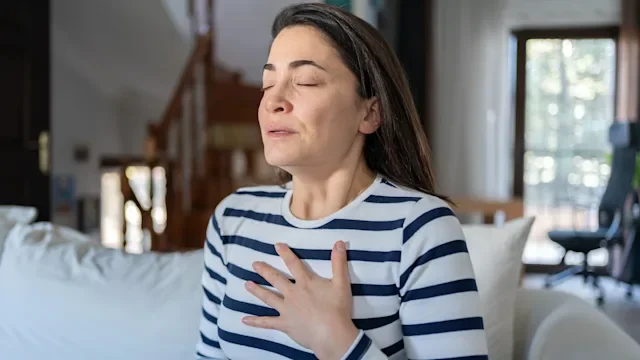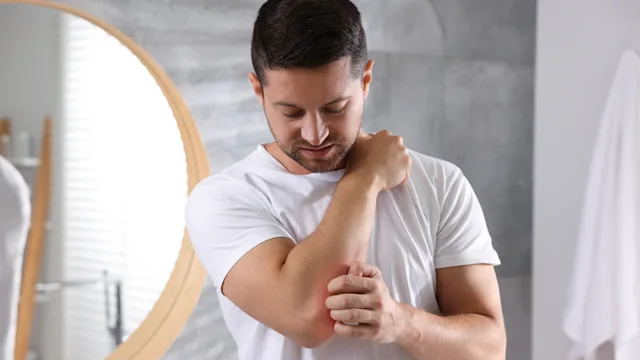Key takeaways:
Bug bites and hives are common rashes that cause itchy bumps.
Sometimes bug bites can look like hives, but there are a few important differences that can help you tell them apart.
Most of the time you can treat hives and bug bites easily at home, but there are some cases when you should contact a healthcare professional.
Not all itchy rashes are alike. Hives and bug bites are common rashes that can easily get confused for one another. They can both cause itching, redness, and bumps on your skin. So how can you tell if a rash is from hives or insect bites?
Hives and bug bites have different causes and characteristics. In this article, we’ll walk you through how to tell the difference between hives and bug bites and when to get medical attention for them.
What do hives look like?
Hives, also known as urticaria, are fairly common. They affect up to 1 in 5 people at some point in their life.
Search and compare options
When someone develops hives, their skin forms swollen, itchy, and sometimes bumpy patches of skin, commonly called “welts” or “wheals.” In fair skin, they’re usually red. But in darker skin tones, they may be violet or skin-colored. They can occur anywhere on your body.
Hives can develop due to a variety of things including:
Allergens like plants or pet dander
Unknown triggers
Usually, wheals appear quickly and disappear just as fast within a few hours — and then reappear in a different location. With acute hives, symptoms go away in days to weeks. But with chronic hives, wheals can come and go over weeks to months. If your hives aren’t going away, or you can’t figure out the cause, it may help to see a dermatologist.
Pictures of hives


What do bug bites look like?
Bug bites can look different depending on the insect. But there are some typical features to look for:
Quick onset of pain or itching at the site of the bite
Either a single or grouping of small, swollen bumps on the skin, sometimes with a blister
Skin bumps are red, violet, or skin-colored, depending on your underlying skin tone.
The rash is limited to the location of the bite(s) and tends to affect a smaller area than hives.
The rash and itchiness develop quickly and improve within a few days to a week.
Think every bump on your face is a pimple? Think again. From keratosis pilaris to milia, some common skin conditions masquerade as acne — but need totally different treatment. Learn what’s really behind those mysterious facial bumps.
Mosquito bites or bedbugs? These photos will help you tell. This side-by-side photo guide breaks down the key differences between mosquito bites and bedbug bites — so you can stop guessing and start taking action.
Why mosquito bites itch like crazy — and how to make it stop. Here’s what’s really going on under your skin after a mosquito bites — and the best ways to calm the itch before it drives you nuts.
Feel like a mosquito magnet? It’s not your imagination — and science has some surprising answers. Learn why some people are more likely to get bitten (and what you can do about it).
It’s possible for an insect bite to trigger local hives around the bite, but these will usually not be widespread.
Pictures of bug bites


Hives vs. bug bites
To help you understand the differences between hives and bug bites, check out the comparison chart and pictures below.
Bug bites | Hives | |
|---|---|---|
Causes/triggers | Insect stings or bites | • Medications • Foods • Infections • Allergens • Stress • Unknown triggers |
Symptoms | Itching and pain at the site of the bite or sting | Itching all over the skin |
Location | Anywhere on the skin where an insect has bitten or stung | Can be anywhere on the body and change quickly |
Appearance | • Small, raised bumps, usually round • Red, violet, or skin-colored • May have noticeable bite or sting marks | • Raised, swollen patches of skin • Red, violet, or skin-colored • Can be any shape or size (as small as a fingertip or larger than the palm of your hand) |
Treatment | • Wash the bite or sting site with soap and water. • Topical steroid cream • Antihistamines • Anti-itch pastes • Ice packs • Oatmeal baths • Cotton clothes | • Elimination of the trigger • Antihistamines • Sometimes oral steroids or a leukotriene receptor antagonist, cyclosporine A, or omalizumab medication are needed. • Oatmeal baths • Cotton clothes |
Bug bites vs. hives pictures




Can bug bites turn into hives?
Sometimes, bug bites can trigger hives to develop. But a bug bite won’t transform into hives. If there are multiple bug bites in a certain area, they may look very similar to hives. But they won’t act the same as hives. The rash and itchiness will remain in that localized area.
Read more like this
Explore these related articles, suggested for readers like you.
Causes of itchy skin bumps that aren’t bug bites
Itchy red bumps don’t always mean you’ve been bitten by something. Other than hives, there are many common skin conditions that can mimic the look and feel of bug bites. Here are some of the most common.
Contact dermatitis: This is an allergic skin reaction to irritants like soaps, nickel, cosmetics, and even plants (like poison ivy). Contact dermatitis looks like red, itchy bumps or blisters that may ooze or crust over. The rash typically shows up where the skin touched the trigger, often in a streaky or linear pattern.
Folliculitis: When hair follicles become infected or inflamed, often caused by friction. Folliculitis looks like small red, violet, or pus-filled bumps around hair follicles. These bumps often show up in areas prone to shaving, sweating, or rubbing, like the thighs, buttocks, beard area, and even elbows.
Scabies: This is a contagious skin infestation caused by tiny mites burrowing into the skin. The infection causes lines or clumps of tiny, very itchy bumps, commonly between fingers, around wrists, elbows, or the waistband area.
Molluscum contagiosum: This is another highly contagious skin infection caused by a virus. It’s usually only seen in children, who get small, round skin bumps that have a waxy or pearly appearance. The bumps aren’t itchy at first, but they can become inflamed and itchy, and look like insect bites.
Pityriasis rosea: This rash can be itchy and causes a single large patch (the “herald patch”) followed by many smaller oval bumps or scaly spots. It’s not fully understood what causes this rash, but experts agree that it’s probably viral.
Miliaria (heat rash): Blocked sweat ducts can cause an outbreak of tiny, itchy bumps. These can be red, violet-brown, or clear, depending on your underlying skin color. The rash is more common in hot, humid climates, and especially under tight clothing or in skin folds.
Drug reactions: An allergic reaction to medication can cause widespread bumps or welts that resemble hives or bites. Usually, these appear a few days after starting a new medication and may include other symptoms like fever or swelling.
Bedbugs: Although these are technically a type of bug bite, they are worth mentioning separately here, since the problem won’t go away without eradicating bedbugs from your home. With bedbugs, you get itchy bumps that develop overnight on exposed skin like arms, neck, or face. These bumps are red or violet, depending on your skin tone, often in a straight line or zigzag pattern. They’re caused by bedbugs that feed on your blood while you sleep.
When should you get care for bug bites or hives?
Most of the time, both bug bites and hives can be easily treated at home. Antihistamines and topical treatments like anti-itch creams and oatmeal baths can help with itching. Wearing breathable materials like cotton can help avoid further skin irritation. Depending on the cause, other prescription medications can often help with recurring hives.
However, there are some signs and symptoms that are more worrisome. Get medical attention if you notice the following:
Fever
Red streaking away from the bug bite
Blisters or yellow crusting over the bite or hives
Drainage or oozing from the bite
These signs could mean an infection is developing. It’s important to see a medical professional if they appear.
Sometimes your body may be having more of an allergic reaction from the bug bite or hive trigger. You should go to the emergency department if you’re experiencing any of the following symptoms:
Difficulty breathing
Swollen lips, tongue, or face
Chest pain or a fast heart rate
The feeling like your throat is closing
Vomiting
Dizziness
These symptoms could mean you’re having an anaphylactic allergic reaction. This type of reaction is life-threatening, and you should get medical attention immediately.
The bottom line
Most of us will experience some sort of itchy rash in our life. Telling the difference between hives and bug bites can be tricky sometimes. Hives are red, raised, and itchy patches that pop up anywhere on your body and can be triggered by a variety of things. Insect bites, on the other hand, occur at the site of the bite or sting and include one or multiple red, painful, or itchy bumps. Knowing how they’re different can help you understand how to treat hives and bug bites so you can feel better more quickly.

Why trust our experts?


Images used with permission from VisualDx (www.visualdx.com).
References
American Academy of Dermatology Association. (n.d.). Bug bites and stings: When to see a dermatologist.
Kayiran, M. A., et al. (2019). Diagnosis and treatment of urticaria in primary care. Northern Clinics of Istanbul.
Ludmann, P. (2024). What are hives? American Academy of Dermatology Association.
Powers, J., et al. (2023). Insect bites. StatPearls.
Vestergaard, C., et al. (2015). Chronic spontaneous urticaria: Latest developments in aetiology, diagnosis and therapy. Therapeutic Advances in Chronic Disease.
Wedi, B., et al. (2009). Urticaria and infections. Allergy, Asthma & Clinical Immunology.


















